Italian Broccoli Pasta Soup
This Italian Broccoli Pasta Soup is a humble yet vibrant celebration of simple ingredients done right. Rooted in Southern Italian cooking traditions, it transforms pantry staples into something elegant and deeply satisfying.
Tender broccoli is simmered until soft, then smashed into a garlicky, pepper-kissed olive oil sauce that clings lovingly to every strand of pasta. The sharp tang of Pecorino Romano and the bright, aromatic zest of lemon bring balance and lift, creating a dish that is both comforting and refreshingly light.
It’s a soulful, meatless pasta that proves the best flavors often come from the simplest combinations.
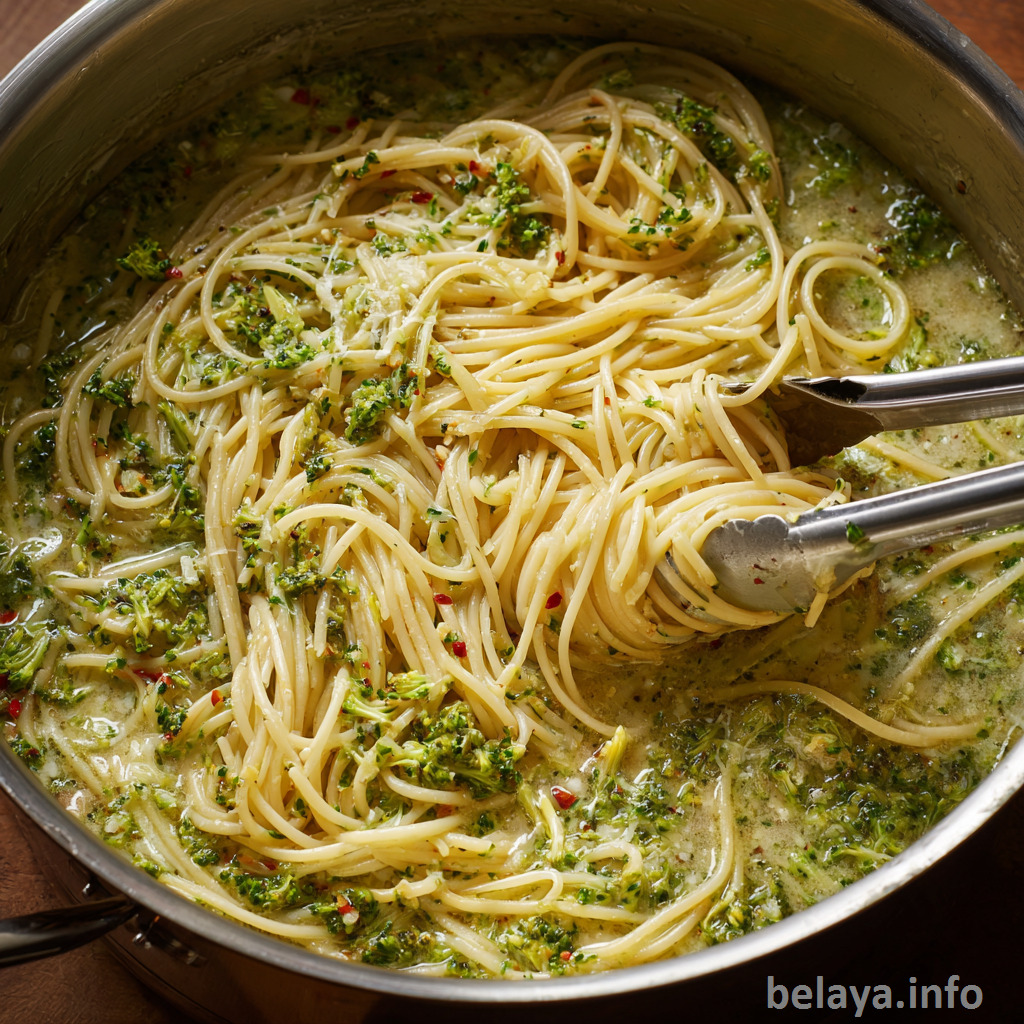
Why People Will Love This Italian Broccoli Pasta Soup:
Balanced simplicity: The recipe celebrates the beauty of minimal ingredients, yet delivers complex flavors through careful technique and contrast—garlic, lemon, and cheese working in harmony.
Nutrient-rich comfort: It’s a wholesome, veggie-forward dish that doesn’t compromise on satisfaction—creamy, hearty, and comforting without the heaviness of cream or butter.
Burst of brightness: The lemon zest adds a vibrant, citrusy lift that cuts through the richness, awakening the palate and refreshing each bite.
Textural contrast: Soft, smashed broccoli with little chunks creates a rustic, almost pesto-like sauce that beautifully coats the pasta while keeping some bite and texture.
Deep umami character: Pecorino Romano brings sharpness, saltiness, and an umami depth that enriches the broccoli and ties the entire dish together.
Pantry-friendly and accessible: Most ingredients are kitchen staples or easy to find, making this an affordable, weeknight go-to without feeling ordinary.
Naturally meatless: A perfect vegetarian option that’s hearty and filling enough to satisfy even the most devoted carnivores.
Mediterranean soul: The olive oil, garlic, and lemon create a timeless Italian flavor profile that feels sun-soaked, rustic, and deeply rooted in tradition.

Key Ingredients:
Broccoli: The heart of the dish, broccoli is simmered until tender, then gently mashed to create a rustic, nutrient-dense sauce that clings to every noodle. Its earthiness anchors the dish with both flavor and fiber.
Extra Virgin Olive Oil: This golden base infuses the pasta with a silky richness and carries the flavors of garlic and red pepper throughout the dish, adding body and depth.
Garlic & Crushed Red Pepper: Together, they form the aromatic backbone—warming, pungent, and slightly spicy—infusing the oil and broccoli with a bold, unmistakably Italian character.
Pasta: Acts as both a vehicle and partner to the sauce; shapes like orecchiette or rigatoni with ridges help capture every bit of smashed broccoli and cheese.
Lemon Zest: Adds brightness and acidity that lifts the richness of the cheese and olive oil, making each bite vibrant and refreshing.
Pecorino Romano: A bold, salty sheep’s milk cheese that melts into the pasta water and broccoli to form a creamy, emulsified coating—salty, tangy, and full of umami.

Expert Tips:
Use starchy pasta water like gold: Reserve at least 1 cup of the pasta cooking water. The starches help emulsify the olive oil and cheese into a silky sauce that clings perfectly to the pasta and broccoli mash.
Smash, don’t puree: Use a potato masher or sturdy fork to gently break down the broccoli. Avoid using a blender—it’s meant to be rustic, with some small chunks remaining for texture and visual contrast.
Infuse the oil low and slow: Don’t rush the garlic and red pepper step. Let the olive oil warm gently so the garlic sweetens rather than burns, releasing its natural oils into the base of the sauce.
Choose pasta with texture: Opt for short, ridged pasta like orecchiette, fusilli, or rigatoni. These shapes trap the smashed broccoli and cheese more effectively than smoother varieties.
Add cheese off the heat: Pecorino Romano should be stirred in after the heat is turned off to avoid clumping or greasy separation. This ensures a smooth, creamy finish that binds everything together.
Use lemon zest generously—but never juice: The zest brings out the bright citrus aroma without adding excess acidity that could clash with the cheese and broccoli.
Balance salt mindfully: Pecorino is quite salty, so season the pasta water well, but taste the final dish before adding extra salt to avoid overdoing it.
Finish with raw olive oil: A final drizzle of high-quality extra virgin olive oil before serving adds a fragrant, grassy note and a luxurious mouthfeel that elevates the dish.
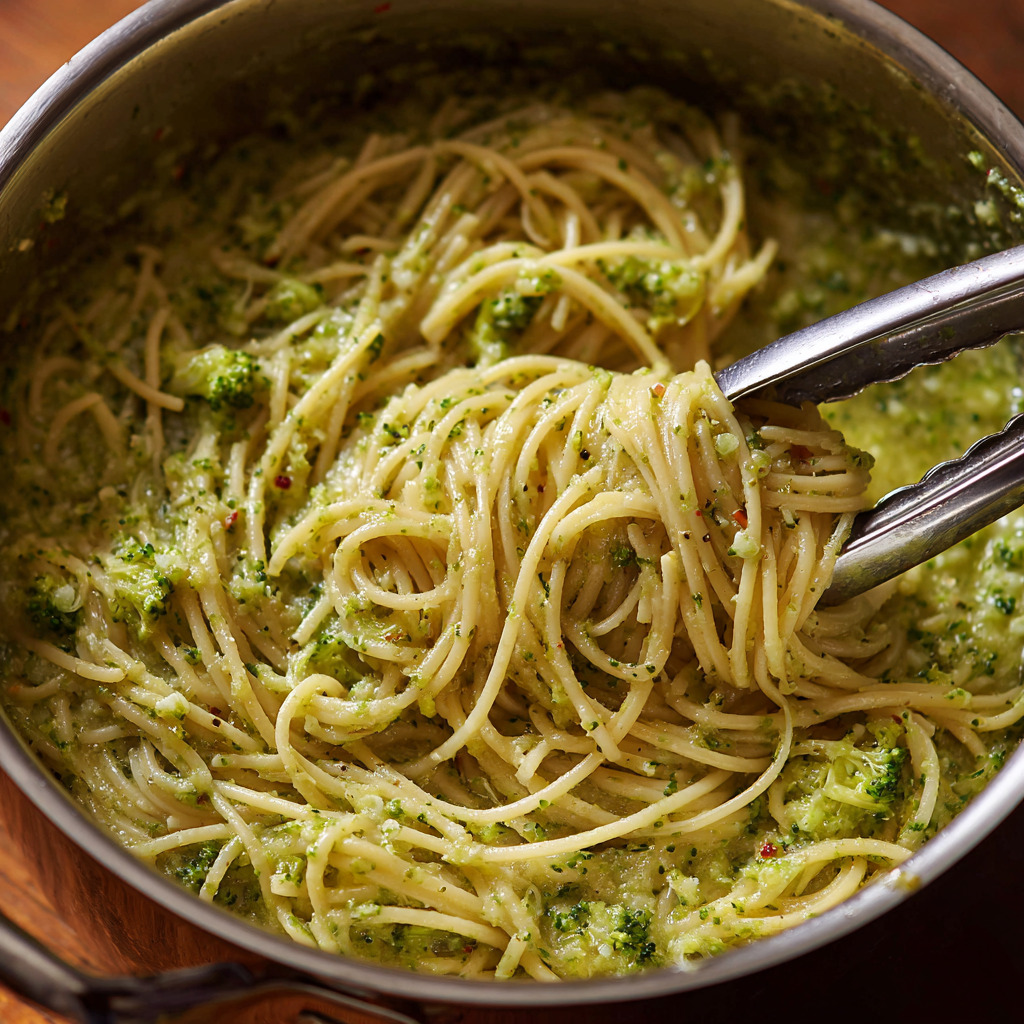
How to make Italian Broccoli Pasta Soup
Ingredients:
4 Tbsp extra virgin olive oil + extra for finishing
3 Tbsp chopped garlic
Pinch crushed red pepper
2 pounds frozen broccoli florets, defrosted (See NOTE below if using fresh.)
1 pound pasta + salt for pasta water (See NOTE below for best options.)
½ tsp salt
¼ tsp black pepper
Zest from 1 lemon (Use more if you want!)
1 cup grated Pecorino Romano cheese
Instructions:
Step 1:
Prep all ingredients according to specifications above.
Bring a large pot of water to a boil.
Then, combine the olive oil, garlic and crushed red pepper in a large pan over medium-low heat and cook until the garlic starts to soften and brown lightly.
Stir occasionally.
Step 2:
Once the pasta water comes to a boil, add salt, then the broccoli, stirring frequently.
Cook the broccoli for 4-5 minutes only–until it becomes soft and “smashable”.
Test this out by piercing a piece with a fork. (Fresh broccoli will take longer to soften than frozen broccoli.)
Step 3:
Using a hand strainer or spider, transfer the broccoli from the boiling water to the pan with the garlic.
Then, add the pasta to the boiling water.
Step 4:
While the pasta is cooking, use either a potato masher or large fork and smash the broccoli into small pieces.
Leave a few small chunks.
Season with the salt and black pepper.
Step 5:
Cook the pasta for 2 minutes less than the package directions, or about 2 minutes before you think it is al dente.
Be sure to reserve at least 1 cup of the starchy pasta water.
Step 6:
Transfer the cooked pasta and about ½ cup pasta water to the pan with the broccoli, along with the lemon zest, and toss well, allowing the pasta to finish cooking in the delicious flavors of the sauce.
Add additional pasta water if more moisture is needed.
Step 7:
Make sure the sauce and pasta are well-combined, then turn off the heat.
Fold in the cheese and mix very well–thecheese should become a bit emulsified and melt into the dish.
Step 8:
Drizzle all with a little extra-virgin olive oil, transfer to serving dishes and enjoy!
Buon Appetito!
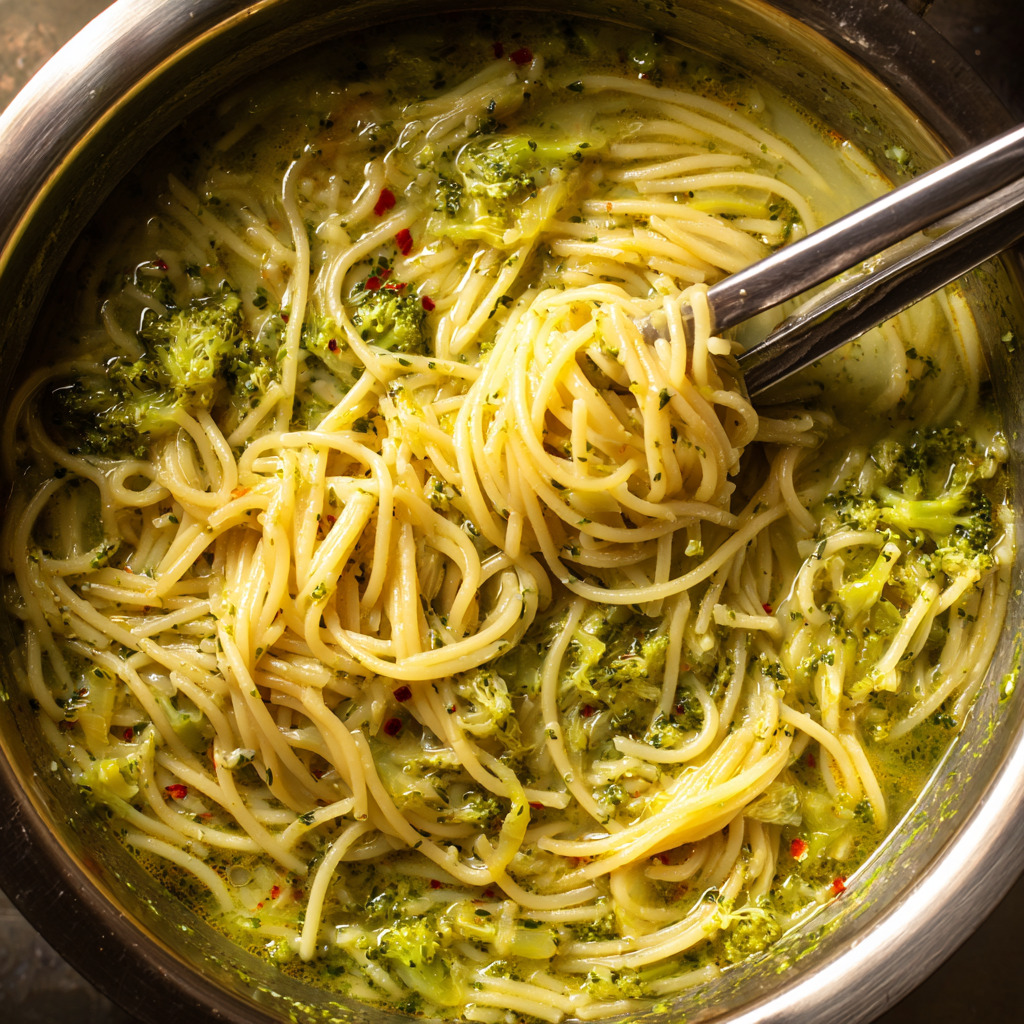
Important Notes When Making Italian Broccoli Pasta Soup:
Fresh vs. frozen broccoli: Both work beautifully, but frozen broccoli softens faster and gives a creamier texture when smashed. If using fresh, chop it into small florets and allow more time for boiling until fork-tender.
Timing is everything: The key to a silky sauce is coordination—start the broccoli before the pasta, and begin smashing while the pasta cooks. This keeps everything hot and melds flavors naturally without overcooking anything.
Salt strategically: This recipe has several salty elements—salted pasta water, Pecorino cheese, and potentially salted broccoli water. Taste often and adjust at the end rather than salting aggressively up front.
Don’t overcook the garlic: Garlic that browns too much becomes bitter and can overpower the dish. Watch closely and reduce heat if it begins to color too fast.
Zest, not juice: Lemon zest provides bright aromatics without the acidity of juice, which can curdle the cheese or clash with the savory depth of the sauce.
Cheese quality matters: Use freshly grated Pecorino Romano for the best melt and flavor. Pre-grated or shelf-stable cheese can clump or taste waxy, disrupting the creamy finish.
No cream needed: The sauce achieves richness naturally through the emulsification of olive oil, cheese, and pasta water—resist the urge to add dairy or butter.
Best served immediately: This dish shines when eaten fresh, while the sauce is hot and glossy. Leftovers are still good, but the silky texture is most vivid straight from the pan.
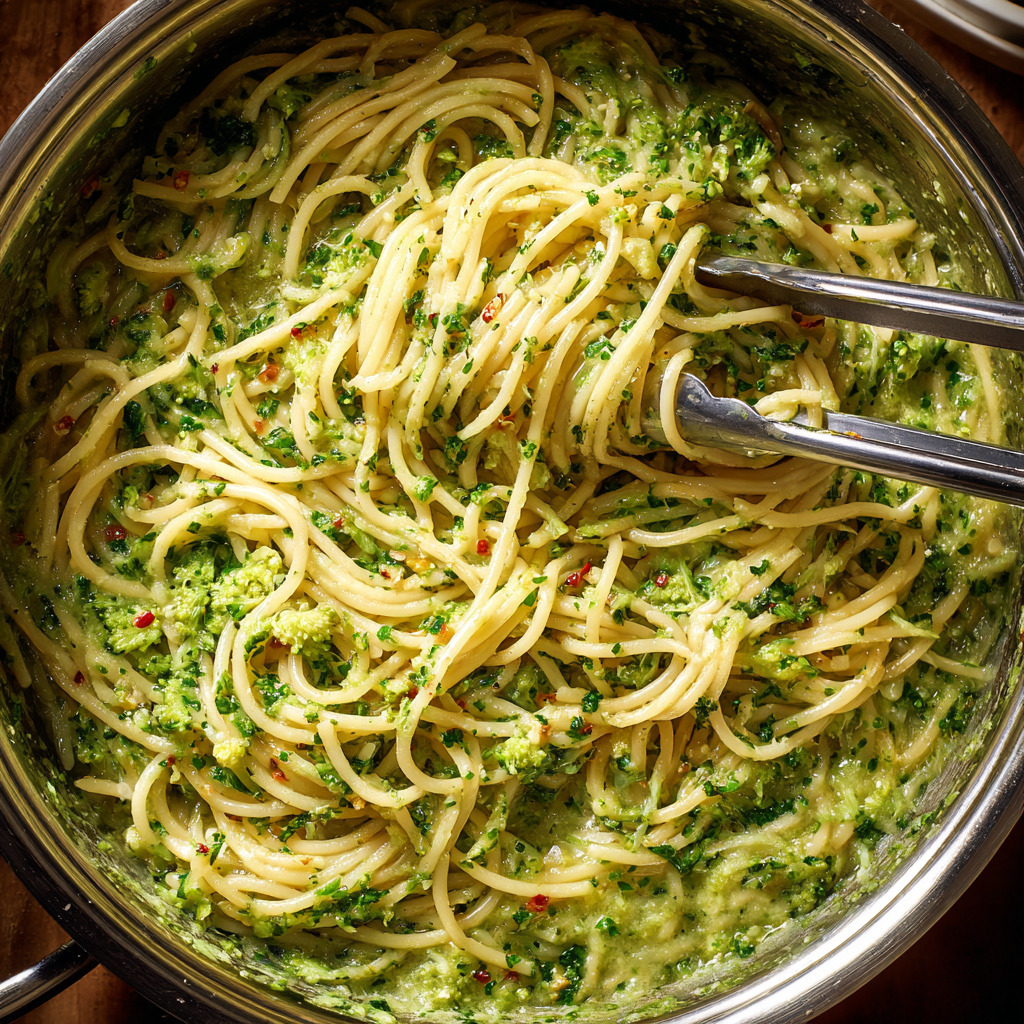
How To Enjoy This Italian Broccoli Pasta Soup:
Right After Cooking: Savor It Fresh
Serve immediately: This pasta is best enjoyed right out of the pan while it’s hot, glossy, and creamy. The emulsified sauce will coat the pasta beautifully—don’t wait too long or it may begin to thicken or dry.
Use warm bowls: Pre-warm your serving bowls to help maintain the pasta’s temperature and creamy texture as it hits the table.
Finish with flourish: Drizzle a final touch of good-quality extra virgin olive oil on top and an extra pinch of lemon zest or Pecorino Romano to awaken the aromatics just before serving.
Pair It Thoughtfully
Wine pairing: A crisp, dry Italian white wine like Verdicchio, Pinot Grigio, or Gavi will complement the brightness of the lemon and cut through the richness of the olive oil and cheese.
Non-alcoholic: Sparkling water with a lemon twist or herbal iced tea (like mint or chamomile) makes a refreshing pairing that doesn’t compete with the flavor.
Round Out the Meal
Simple green salad: A light arugula or baby spinach salad with lemon vinaigrette adds freshness and contrast without overpowering the dish.
Toasted bread: Serve with crusty Italian bread or crostini to mop up every bit of the sauce—it makes the meal feel more indulgent.
Set the Mood
Relaxed elegance: Light a candle, play soft Italian music (instrumental or vocal), and dine slowly. This dish is simple but soulful—lean into the Mediterranean spirit of slow, joyful eating.
Family-style or solo: It’s equally wonderful served family-style for a cozy dinner or plated individually for an elevated solo meal.
Leftover Enjoyment
Storage: Store in an airtight container in the fridge for up to 2 days.
Reheating: Reheat gently in a pan with a splash of water or olive oil to revive the sauce without drying it out. Add a fresh grating of Pecorino and a hint of lemon zest to bring it back to life.
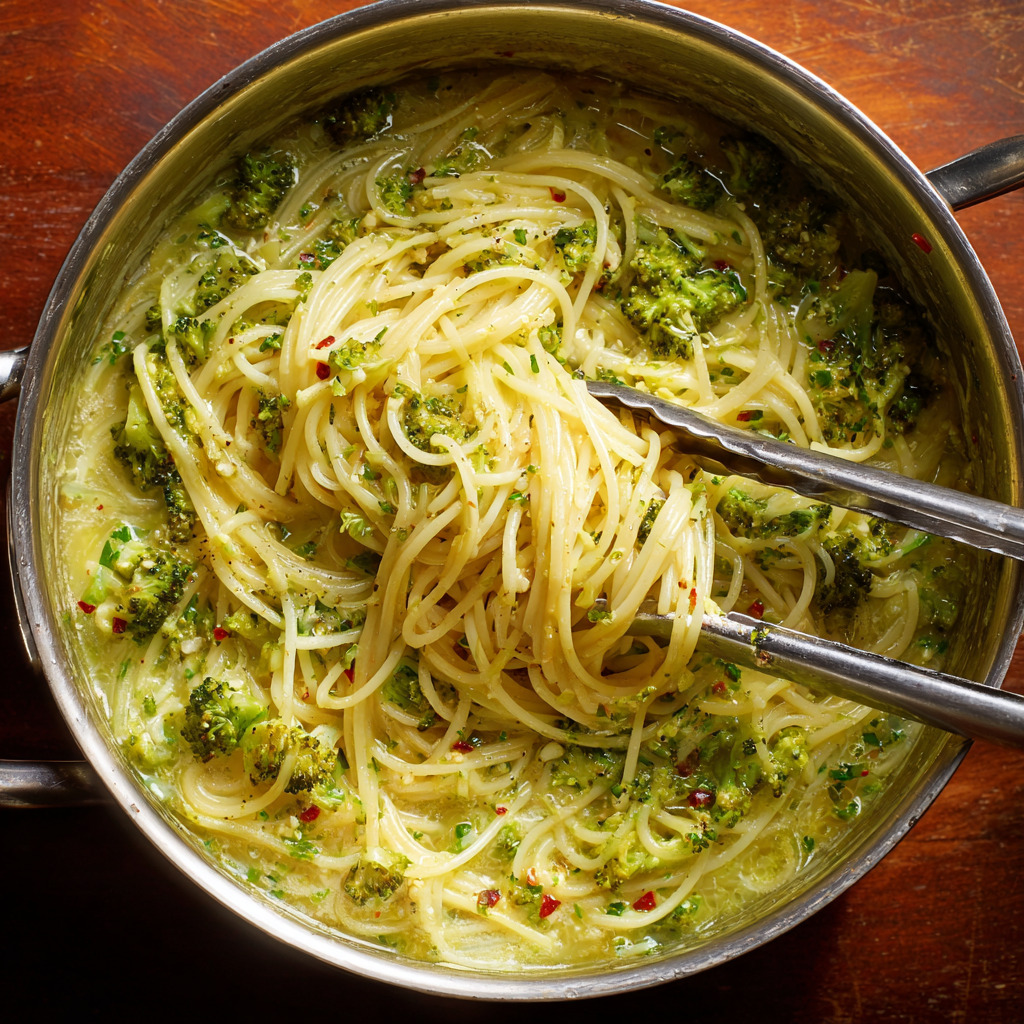
Nutrition Information:
For one serving of Italian Broccoli Pasta with Pecorino and Lemon, assuming the recipe makes 6 servings:
Calories: 425 kcal | Total Fat: 17.2 g | Saturated Fat: 4.1 g | Monounsaturated Fat: 9.3 g | Polyunsaturated Fat: 1.8 g | Cholesterol: 15 mg | Sodium: 380–500 mg (depending on added salt) | Total Carbohydrates: 53.5 g | Dietary Fiber: 6.8 g | Sugars: 3.2 g | Protein: 15.6 g

Frequently Asked Questions:
Can I use fresh broccoli instead of frozen?
Yes! Fresh broccoli works beautifully, though it takes a bit longer to soften. Cut it into small florets and simmer in salted boiling water for 6–8 minutes until fork-tender. The rest of the recipe stays the same.
What type of pasta works best for this dish?
Short pasta with ridges like orecchiette, rigatoni, fusilli, or cavatappi are ideal—they capture the smashed broccoli and creamy cheese sauce well. Long pasta like spaghetti or linguine can work but may not hold the sauce as effectively.
Can I make this recipe vegan?
Yes, with simple adjustments. Swap Pecorino Romano for a dairy-free alternative like nutritional yeast or a vegan parmesan-style cheese. Also, double-check that your pasta brand is egg-free. The rest of the ingredients are naturally vegan.
How do I avoid clumpy cheese when mixing it in?
Turn off the heat before adding Pecorino Romano and stir it in gradually with a bit of reserved pasta water. This ensures the cheese emulsifies into the sauce rather than clumping or separating due to high heat.
Can I make this dish ahead of time?
It’s best enjoyed fresh, but you can prepare the broccoli sauce in advance and refrigerate it for up to 2 days. When ready to serve, reheat the sauce gently and toss with freshly cooked pasta and lemon zest, then finish with cheese and olive oil.
Why should I cook the broccoli before the pasta?
Cooking the broccoli first allows you to soften it properly so it can be smashed into a creamy sauce. It also lets you reuse the same pot of boiling water for the pasta, saving time and preserving nutrients from the broccoli in the water.
What’s the best way to smash the broccoli without over-mashing it?
Use a potato masher or the back of a large fork and press gently until the broccoli breaks down into small bits. Leave a few chunks for texture—it should be rustic, not puréed.
How much pasta water should I save, and when do I use it?
Save at least 1 cup of pasta water before draining. Start by adding ½ cup to the pan with the broccoli and pasta to help blend the sauce. Add more as needed to loosen and bind the cheese and oil into a silky coating.
How do I avoid overcooking the garlic?
Cook it over medium-low heat and watch closely. Garlic should just begin to soften and turn light golden—not brown or crispy. Burnt garlic adds bitterness and can ruin the sauce’s delicate balance.
When should I add the cheese to keep the sauce creamy?
After turning off the heat, fold in the grated Pecorino Romano. This prevents it from clumping or separating. Stir well with the pasta water to emulsify the cheese into the sauce and create a creamy, luscious finish.